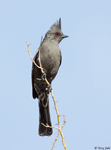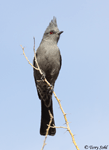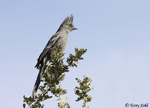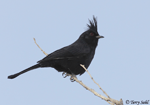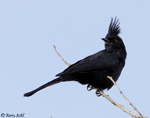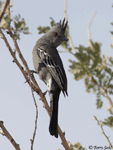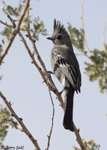| Length: 7.75 inches | Wingspan: 11 inches | Seasonality: Non-resident in South Dakota |
| ID Keys: Sleek and slender body, obvious crest, long tail, glossy black body (male), all gray (female) | ||
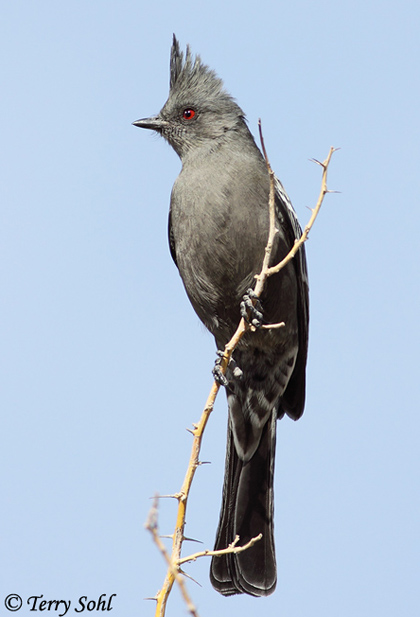 Phainopepla
are unique birds of the desert Southwest of the United States, with a unique
taxonomy. The unusual name comes from the Greek for "Shining Robe", a term
which refers to the glossy black plumage of the adult male. Phainopepla
are often tightly related with the distribution of parasitic mistletoe plants
which are found in the branches of desert trees. A single Phainopepla may
eat over 1,000 mistletoe berries a day. The sticky seeds pass through the
bird's digestive track, and are distributed in the canopy of other trees, where
they may sprout and develop into additional clumps of mistletoe.
Phainopepla
are unique birds of the desert Southwest of the United States, with a unique
taxonomy. The unusual name comes from the Greek for "Shining Robe", a term
which refers to the glossy black plumage of the adult male. Phainopepla
are often tightly related with the distribution of parasitic mistletoe plants
which are found in the branches of desert trees. A single Phainopepla may
eat over 1,000 mistletoe berries a day. The sticky seeds pass through the
bird's digestive track, and are distributed in the canopy of other trees, where
they may sprout and develop into additional clumps of mistletoe.
Habitat: Habitat is variable, often dependent upon time of year. In the spring, they are often found in more open desert habitats where breeding occurs. Habitat at other times of the year often coincides with the availability of berries, and may include riparian woodlands, open oak woodlands, or mesquite shrubland.
Diet: Berries often make up a large portion of the diet, especially mistletoe berries when available. They will also feed heavily on other berries. Insects also comprise a large part of the diet, especially when berries are not as abundant.
Behavior: Phainopepla are often quite conspicuous in their habitat, as they often will perch in the highest branches of mesquite, brush, and small trees. They can be quite territorial, defending patches of berries from intruders, especially when in drier and more open desert environments. Curiously, when nesting in woodlands, they are often quite collegial, with multiple nesting pairs often found in the same tree.
Nesting: Phainopepla build cup-shaped nests of twigs and plant fibers, usually in the crook of a tree or amongst the foliage of mistletoe. As with migratory movements of the species, nesting is somewhat poorly understood for Phainopepla. The species may nest twice a year, and unusually, each breeding period may occur in different habitats. In the spring, Phainopepla often nest in drier, open desert areas. Later in the year, they may nest in small colonies in open woodlands.
Song:
The song of a male Phainopepla is complex,
consisting of a series of unique phrases with pauses in between.
Migration: Movements of Phainopepla are poorly
understood. Local populations can fluctuate significantly from year to
year. Some birds clearly nest in desert areas in the Spring and then
depart, possibly nesting again in other habitats.
Interactive eBird map:
Click here to access an interactive eBird map of Phainopepla sightings
Similar Species:
Generally distinctive, especially in normal range. The other related
species that has been rarely sighted in the United States is the
Gray Silky-Flycatcher.Conservation Status: Populations are generally stable, although local declines
have been noted where suitable habitat has been converted to agricultural or
urban land uses.
Further Information: 1)
Birdweb.org -
Phainopepla
3)
Audubon Guide - Phainopepla
Photo Information: December 10th, 2010 - Saguaro
National Park near Tucson, Arizona - Terry Sohl
Additional Photos: Click on the image chips or
text links below for additional, higher-resolution Phainopepla photos.
Further Information: 1) Birdweb.org - Phainopepla
3) Audubon Guide - Phainopepla
Photo Information: December 10th, 2010 - Saguaro National Park near Tucson, Arizona - Terry Sohl
Additional Photos: Click on the image chips or text links below for additional, higher-resolution Phainopepla photos.
| Click on the map below for a higher resolution view |
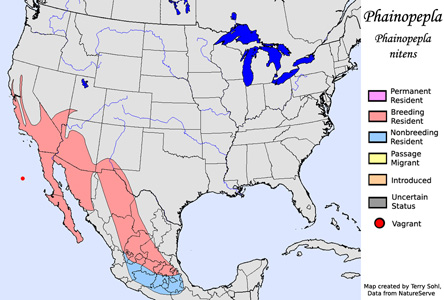 |
| South Dakota Status: Non-resident in South Dakota |
Additional Phainopepla Photos
Click for a higher-resolution version of these photos
